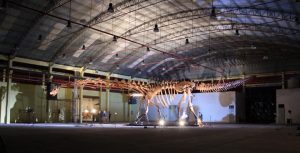The very word Dinosaur means terrible lizard and ever since human science realized that huge reptiles once dominated the Earth the search has been on for paleontologists to find the biggest, the most awe inspiring dinosaur of them all. The first specimens of Brontosaurus stunned the public with their size but they soon gave way to the Diplodocus who in its turn was outclassed and outmassed by the Seimosaurus. These huge long necked, long tailed sauropod dinosaurs have even been given the group name of Titanosaurs to convey their immensity.
Now a new contender for the title of world’s largest animal has been announced and named. Based on fossils discovered in the Patagonian region of Argentina, Patagotitan mayorum is believed to have measured more than 35 meters in length and to have possessed a mass of greater than 60,000 kilos, about 12 times the mass of the current largest land animal the African Elephant. The picture below shows the assembled skeleton of Patagotitan mayorum in a warehouse.

The bones of Patagotitan Mayorum were first discovered in 2014 by the Argentinean paleontologists Jose Luis Carballido and Diego Pol of Argentina’s National Scientific and Technical Research Council. The two scientists have spent the last three years carefully digging up and analyzing the bones before officially naming their prize. In addition to its extreme size the fossils of Patagotitan discovered are also an unusually complete skeleton and researchers hope this specimen will enable us to learn more about how the sauropod dinosaurs evolved into such behemoths.
As exciting as the announcement of Patagotitan Mayorum is I have to wonder why three different news stories insisted on proclaiming the find as “New Dinosaur bigger than T-rex”! That’s a bit like saying a new species of Elephant has been discovered and it’s huge “Bigger than a lion!” Yes, plant eaters are often considerably larger than their predators (Think Bison and Wolves) and T-rex is not the standard against which every dinosaur has to be measured.
Another important fossil discovery announced this past week concerns our own species and our closest relatives the great apes. Now to remind you, in the world today there are four species of great apes: chimpanzees, gorillas, orangutans and ourselves, along with one species of lesser ape the gibbons. That’s all that are left in the world today but 10 to 20 million years ago there were dozens of other now extinct species of ape in the world.
Recently a nearly complete 13 million year old skull of a baby ape was discovered in Kenya. Nicknamed ‘Alesi’ by its discoverer John Ekusi the creature was likely a fruit eating, climbing primate that resembled a gibbon. The image below shows the fossil skull of Alesi.

According to the study’s co-author Craig Feibel, chair of the anthropology department at Rutgers University in New Jersey, the age and location of this fossil make it very important. “The…locality offers us a rare glimpse of an African landscape 13 million years ago.” It is hoped that Alesi will tell scientists a great deal about how the great apes, including our ancestors, split off from the many species of lesser apes.
An examination of the unerupted adult teeth indicates that Alesi belonged to an already established genus of apes called Nyanzapithecus but to a new species that has been named Nyanzapithecus alesi.
The authors of the study are unsure how Alesi died but a layer of volcanic ash from a huge eruption that occurred in eastern Africa 13 million years ago covered the skull and it is possible that Alesi died in that eruption.
If you’d like to read more about the discovery of Alesi click on the link below to be taken to the Scientific American article.
